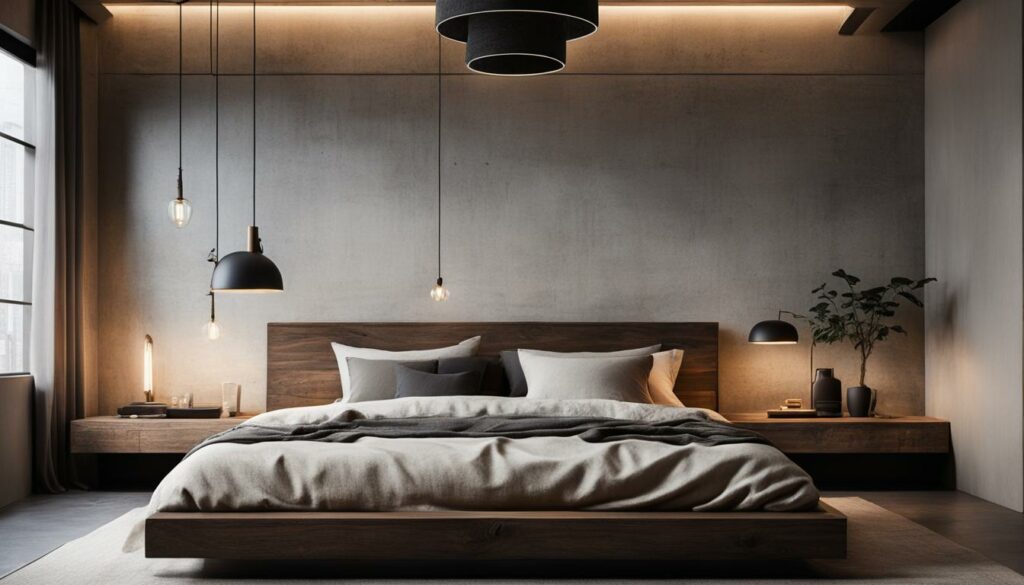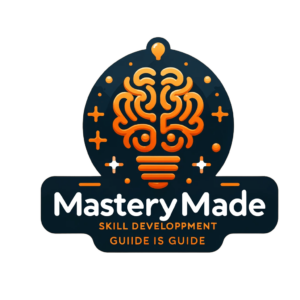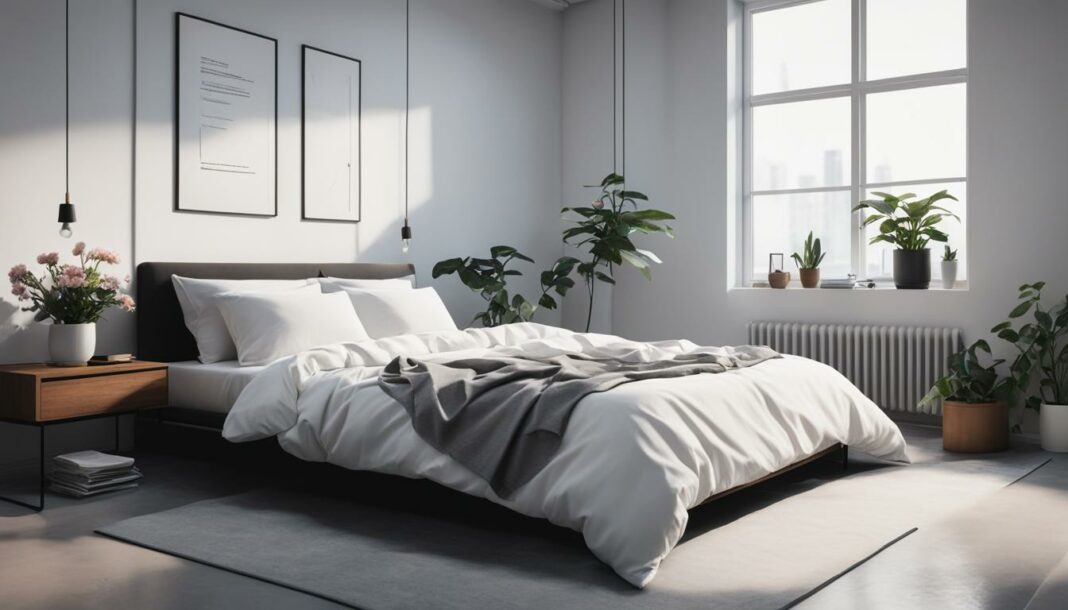We all seek a breath of fresh air amidst the chaos that often surrounds us. At the core of what we do, we yearn for a sense of tranquility and order, both in our minds and our habitats. With a thoughtful nod to Minimalist Mastery, we’re here to open the door to a world where less is infinitely more. Through these carefully curated decluttering tips, we aim to help you embark on a journey towards a minimalist lifestyle, fostering simplified living practices that can streamline our existence.
In our quest for serene spaces, both interior and exterior, we are often held back by the weight of our possessions and the clutter of our thoughts. Yet, the step towards minimalism need not be daunting. Together, we’ll walk through intuitive hacks that cut through the clutter, creating room to breathe and space to grow. Let’s reshape our environments and our mindsets to reflect the peaceful life we all deserve.
Key Takeaways
- Discover how embracing Minimalist Mastery can transform your daily routine.
- Learn actionable decluttering tips to streamline both your home and your mind.
- Understand how a minimalist lifestyle promotes a sustainable and simplified living experience.
- Adopting key strategies can lead to a profound sense of clarity and calm.
- Recognize the symbiosis between mental space and physical environments in fostering well-being.
Implement a Minimalist Mindset for Simplified Living
Welcome to the transformative world of minimalism for beginners, where we embark on the journey towards mindful living with a minimalist mindset. Embracing simplicity isn’t just about having fewer possessions; it’s about cultivating an inner sense of peace and clarity. Let us guide you through the core principles of this life-enhancing philosophy.
Understanding the Core Principles of Minimalism
At its heart, minimalism is about paring down to what truly matters. It’s about eliminating the excess to make room for what brings you joy, fulfillment, and tranquility. Intentionality is key; each choice, each possession, and each activity should be meaningful and add value to your life. With each mindful decision, we step closer to a life of purpose and contentment.
Starting Small: Mindful Moments and Daily Practices
Adopting a minimalist lifestyle doesn’t happen overnight. It’s about starting small, incorporating mindful moments and daily practices into your routine. Perhaps it begins with decluttering a single drawer, or choosing to spend a quiet hour each morning free from digital distractions. These actions lay the bricks for a strong foundation of minimalist living, gradually attuning our minds to appreciate simplicity.
- Decluttering a personal space once a week
- Setting aside time for reflection and meditation
- Choosing quality over quantity in new purchases
- Limiting social media to create more ‘real-world’ connections
- Incorporating moments of stillness into each day
Benefits of a Decluttered Mind on Wellbeing
The tranquility of a decluttered mind extends far beyond a tidied room or a sparse closet; it permeates our entire well-being. Shedding the unnecessary can lead to reduced anxiety, heightened focus, and a deeper sense of happiness. By embracing minimalism, we’re not just clearing our environments; we’re clearing the pathways to our mental and emotional health.
“The beauty of minimalism isn’t in what it takes away, but in what it gives.” – Simplified living allows us to make more room for growth, creativity, and serenity in our lives.
So, as we continue our quest for a minimalist mindset, remember that the goal isn’t to have less for the sake of less but to have more of what matters most. More time, more clarity, more peace. That is the true essence of living a minimalist life.
Minimalist Design Strategies for Your Living Spaces
When we think of minimalist design, images of serene, uncluttered rooms might spring to mind—a hallmark of minimalist home decor. It’s not just about less being more; it’s about making each piece count. Let’s dive into some tangible strategies that can guide you in creating a minimalist oasis.
Color plays a pivotal role in minimalist aesthetics. Choosing the right palette is about balance—muted, neutral tones that provide a calming effect, along with strategic pops of color to bring vibrancy without overwhelming the senses. For textures and materials, think simplicity and quality. Rich wood, smooth stone, and textiles like wool or linen can bring warmth and depth to a minimalist space.
Furniture selection is another critical factor. Pieces with clean lines and functional design can significantly declutter a room. Opt for items that serve multiple purposes or that can be easily stored to maintain an open, airy feel. Remember, each item in your minimalist space should serve a purpose or bring you joy.

Organization and Storage: Out of sight, but not out of mind. Effective storage solutions are vital in a minimalist home. Creating built-in storage or using furniture with hidden compartments keeps clutter at bay and maintains the cleanliness of your design.
| Element | Role in Minimalist Design | Examples |
|---|---|---|
| Lighting | Creates atmosphere and highlights decor | Recessed lighting, simple pendant fixtures |
| Accent Pieces | Adds personality without clutter | One statement artwork, potted plants |
| Textiles | Brings comfort and texture | Neutral-colored throw pillows, natural fiber rugs |
As we focus on minimalist design, it’s essential to consider the impact of each choice on your overall wellbeing. The right decor not only looks good but feels good too, manifesting a tranquil setting for daily living. A minimalist approach is not just about decoration; it’s a lifestyle that cherishes simplicity, functionality, and beauty in every corner of your home. Embrace these tips and transform your living space into a minimalist sanctuary that reflects a thoughtful and purposeful way of life.
Minimalist Mastery: Master the Art of Letting Go
Embarking on the journey of minimalist mastery is, at its core, a profound exercise in letting go. What many don’t anticipate is the depth of emotional decluttering required to pave the way for a true minimalist organization. It’s not simply about discarding items, but also about severing the invisible strings that tie us to our clutter.

The Emotional Side of Decluttering
As we confront the piles of possessions, we also face a mosaic of memories, regrets, and aspirations. The art of letting go necessitates courage – to release the past and embrace the space, both physical and emotional, that will open up.
“Letting go does not mean forgetting; it means freeing up emotional space for the future.”
Practical Steps to Embrace Minimalist Mastery
For those ready to embark on this transformative journey, here are practical steps to declutter with intent:
- Assessment: Survey your space to identify what truly adds value to your life.
- Categorization: Sort items into groups – keep, donate, sell, or dispose of responsibly.
- Action: Take immediate action with the items you’ve decided to part ways with to prevent second-guessing.
| Category | Action | Result |
|---|---|---|
| Clothes | Donate to charity | Clear closet space |
| Books | Start a book exchange | Community engagement |
| Mementos | Keep select items | Preserve meaningful memories without the clutter |
| Electronics | Sell or recycle | Reduce environmental impact |
Overcoming Resistance and Mental Blocks
We understand that the path to minimalist mastery is often met with mental resistance. Doubts and attachments can cloud our mission, turning letting go into a formidable foe. The key to overcoming these blocks is to refocus on the rewards of a decluttered existence – clarity, space, and a renewed sense of freedom are just on the other side of letting go.
- Remind yourself why you started: revisit your goals often.
- Become aware of your emotional triggers and address them directly.
- Seek support from a community of minimalists who share your vision.
As we navigate the complexities of emotional decluttering, we invite you to move forward with us, armed with resilience and a blueprint for minimalist organization. Together, we can redefine what truly matters and create space for new growth and experiences. Let go, and let the mastery of minimalism enrich your life.
Create a Sanctuary with Minimalistic Fashion and Possessions
We’ve navigated through the principles and practices of minimalist living, and now, we approach the finishing touches that make a significant impact—our fashion choices and the possessions we cherish. In this final stretch, we solidify our minimalist mastery by infusing it into the very fabric of our daily wear and the treasured items we choose to retain in our lives. It’s here that minimalistic fashion and carefully curated belongings come together to craft a peaceful refuge that echoes our newfound ethos of ‘less is more’.
How to Choose Quality over Quantity
As we refine our minimalist sanctuary, the mantra of choosing quality over quantity becomes instrumental. We advocate for investments in high-quality garments and possessions that promise longevity and enduring style. This isn’t just a selective approach to shopping; it’s a commitment to values that prioritize sustainability and craftsmanship. By selecting fewer items that are built to last, we reduce waste and contribute to a more thoughtful consumer culture—hallmarks of a true minimalist lifestyle.
The Role of Personal Style in Minimalism
Minimalism doesn’t equate to a lack of personality; quite the contrary. Our personal style is the distinctive signature in our minimalist narrative. It reflects our unique identity and should align harmoniously with our minimalist philosophy. We aspire to demonstrate that minimalistic fashion isn’t restrictive but rather a liberating way to express ourselves with intentionality. It’s about distilling our closet to those pieces that truly speak to who we are, paring down to the essentials that feel authentic and empowering.
Cultivating a Capsule Wardrobe for Everyday Ease
A well-curated capsule wardrobe stands at the heart of minimalistic fashion, embodying the essence of quality over quantity. This strategic collection of versatile and interchangeable pieces simplifies decision-making and ensures we’re always effortlessly polished. The beauty of a capsule wardrobe lies in its ease, freeing us from the daily dilemma of ‘what to wear’ and allowing us more time and energy to dedicate to our passions. By embracing this selective approach to our attire, we harness the true power of minimalist mastery, crafting an everyday existence that is streamlined, stress-free, and deeply fulfilling.
FAQ
What are the first steps to adopting a minimalist lifestyle?
The first steps involve understanding what minimalism means to you and focusing on what’s essential. Start by decluttering your space and mind, identifying the items and thoughts that serve no positive purpose, and mindfully removing them to create room for what truly matters.
How do I begin decluttering if I feel overwhelmed?
Begin with small, manageable tasks. For instance, dedicate five minutes each day to declutter a specific area or category. As you experience the benefits, you’ll gradually build the momentum and confidence to tackle larger decluttering projects.
Can minimalism really improve my mental well-being?
Absolutely. A minimalist mindset can lead to reduced stress, heightened focus, and greater satisfaction by removing unnecessary stimuli and distractions. This decluttered approach to living allows for a clearer mental state and increased peace of mind.
How do I incorporate minimalist design into my home?
Embrace simplicity in your design choices by selecting a neutral color palette, investing in versatile furniture, and leaving plenty of open space. Each item in your living spaces should serve a purpose or bring you joy, ultimately reflecting a serene and harmonious environment.
What does ‘Minimalist Mastery’ entail when it comes to possessions?
‘Minimalist Mastery’ involves being intentional about what you own, choosing to keep only those things that have utility or hold significant personal value. It’s about mastering the art of letting go and resonating more with experiences than with material possessions.
How do you handle the emotional aspect of discarding items?
Acknowledge the emotions attached to items, whether it’s guilt, nostalgia, or fear of loss. By understanding that your memories and experiences are not contained within these objects, you can more freely make decisions focused on your current needs and well-being.
What are practical steps to develop a minimalist organization system?
Start by sorting items into categories, decide what to keep based on its necessity, and design a consistent place for every item. Use containers or dividers if needed, and ensure everything has a purpose. Regularly review and declutter to maintain your system.
How do I create a capsule wardrobe?
Choose timeless pieces that fit your lifestyle and personal style, focusing on quality over quantity. Limit the number of items to only what you need and love wearing, ensuring each piece is interchangeable and coordinates with the rest. Regularly assess and adjust to keep it functional and fresh.
What is the role of personal style in practicing minimalism?
Personal style is fundamental in minimalism because it’s about expression and not excess. By defining your unique style, you can curate a wardrobe and possessions that truly reflect who you are, rather than mindlessly following trends.
What tips do you have for minimalism beginners?
Start by setting clear intentions and simplifying one aspect of your life at a time, whether it’s your closet, your schedule, or your digital space. Practice gratitude and be present, which helps in recognizing contentment with what you have. Remember that minimalism is a personal journey, so proceed at a pace that feels right for you.











